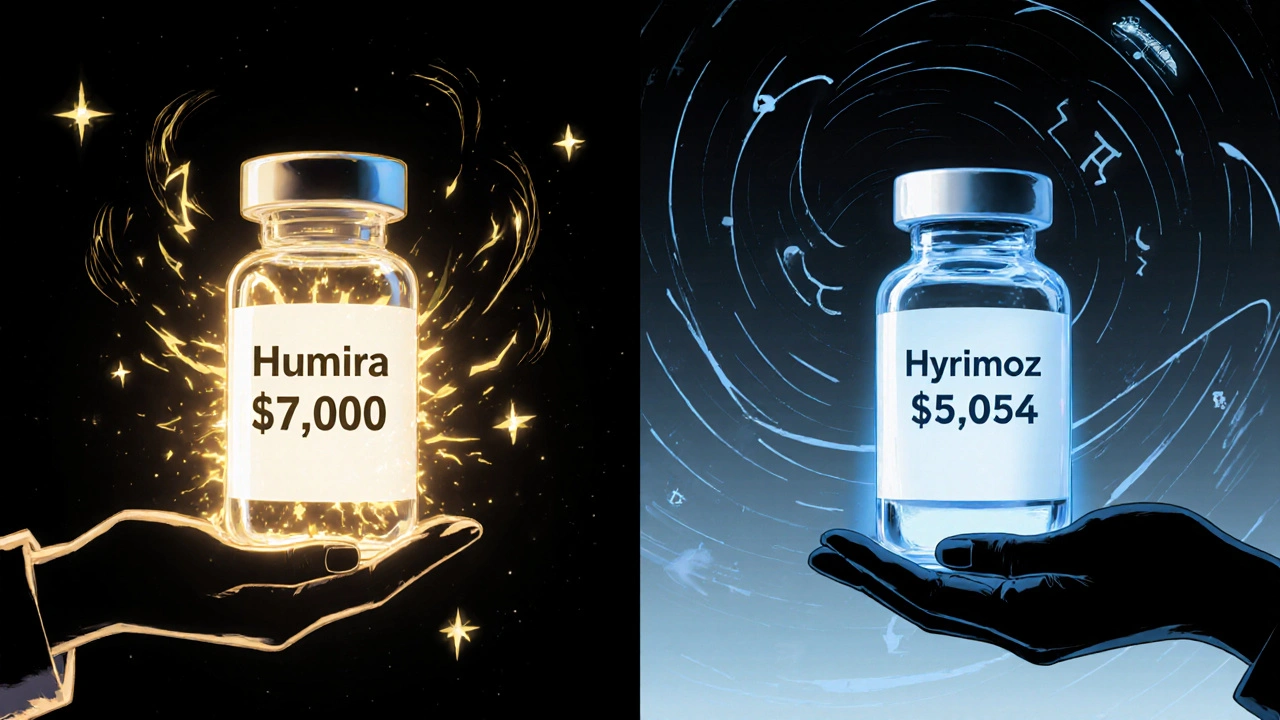Biologic drugs like Humira, Enbrel, and Remicade have changed how we treat autoimmune diseases, cancer, and chronic conditions. But they come with a steep price tag-sometimes over $7,000 a month. That’s where biosimilars come in. They’re not generics. They’re not copies. But they’re close enough to work the same way-and cost a lot less.
What Exactly Are Biosimilars?
Biosimilars are made from living cells-yeast, bacteria, or animal cells-not chemicals. That’s why they can’t be exact copies like generic pills. Even tiny changes in how they’re made can affect how they behave in the body. But that doesn’t mean they’re less effective. The FDA requires them to be highly similar to the original biologic, with no meaningful difference in safety, strength, or how they work.
Think of it like two identical-looking cars built in different factories. Same engine, same fuel efficiency, same safety rating. But one was made in Germany, the other in Japan. The biosimilar isn’t a knockoff-it’s a scientifically validated alternative.
The first biosimilar approved in the U.S. was Zarxio in 2015, a copy of Neupogen, used to boost white blood cells after chemotherapy. Since then, the FDA has approved 45 biosimilars, covering treatments for rheumatoid arthritis, Crohn’s disease, psoriasis, and several cancers.
How Are Biosimilars Different From Generics?
Generics are exact chemical copies of small-molecule drugs like ibuprofen or metformin. They’re made in labs with predictable reactions. Biosimilars? They’re made in bioreactors using living organisms. The process is messy, complex, and hard to replicate perfectly.
Because of this, biosimilars need way more testing than generics. Manufacturers must prove:
- Their molecule’s structure matches the original
- How it behaves in the body (pharmacokinetics) is nearly identical
- It works the same way in clinical trials
- It doesn’t cause more immune reactions
The FDA calls this the “totality of evidence.” It’s not a shortcut-it’s a rigorous process. And it’s why biosimilars cost less, but not as much as generics. While generics can cut prices by 80%, biosimilars typically save 15-30% at first. But that number grows over time.
How Much Do Biosimilars Actually Save?
When Humira biosimilars hit the U.S. market in 2023, their list price was around $5,054 per month-28% lower than Humira’s $7,000. That sounds great. But here’s the catch: list price isn’t what most patients pay.
Insurance, rebates, and pharmacy benefit managers (PBMs) play a big role. In reality, many patients with private insurance still pay the same copay for a biosimilar as they did for the brand-name drug. That’s because manufacturers often rebate the difference to insurers.
Where savings really show up is in Medicare and Medicaid. The Inflation Reduction Act of 2022 cut out-of-pocket costs for biosimilars in Medicare Part D to just 25% starting in 2024. For seniors on fixed incomes, that’s huge.
Studies show biosimilars could save the U.S. healthcare system up to $150 billion by 2030. But that’s only if barriers fall. Right now, patent lawsuits, “product hopping” (when brand companies tweak their drug slightly to delay competition), and payer restrictions slow adoption.
In Europe, biosimilars are used much more widely. For example, 84% of new filgrastim prescriptions in Europe are biosimilars. In the U.S., it’s only 65%. Why? Europe has simpler pricing rules and less legal interference.

Are Biosimilars Safe?
Yes. And the data backs it up.
The NOR-SWITCH trial, published in The Lancet in 2016, followed over 500 patients with autoimmune diseases who switched from the original biologic to a biosimilar. After 52 weeks, there was no increase in side effects, loss of effectiveness, or immune reactions.
Since 2006, the European Medicines Agency has tracked over 16 years of real-world use. No unexpected safety issues have emerged.
The FDA states clearly: “Biosimilars are as safe and effective as their reference products.”
But concerns linger. A 2022 Arthritis Foundation survey of 1,200 patients found that 28% were worried about switching. Most of those worries disappeared after talking to their doctor. Patient reviews on Drugs.com show 4.2 out of 5 stars for biosimilars like Renflexis, with comments like, “Same as Remicade, but half the cost.”
Still, some experts warn about multiple switches. Dr. Almut Winterstein from the University of Florida says switching back and forth between a reference product and biosimilars might need closer monitoring. But switching once? The science says it’s fine.
Can Pharmacists Substitute Biosimilars Automatically?
No-not like generics.
With a generic pill, your pharmacist can swap it without telling you. With biosimilars, rules vary by state. In 48 states, a pharmacist can’t substitute a biosimilar unless the prescriber allows it or the product is labeled “interchangeable.”
Only six biosimilars have that “interchangeable” status as of late 2023. Hyrimoz, the first interchangeable version of Humira, got that designation in July 2023. That means pharmacists can swap it for Humira without asking the doctor-just like a generic.
But even then, many doctors still prefer to make the call. Why? Because patients often worry. And doctors know that trust matters more than policy.

What’s Holding Back Wider Use?
It’s not the science. It’s the system.
Many oncologists and rheumatologists say their biggest challenge isn’t understanding biosimilars-it’s navigating insurance rules. A 2022 survey by the American Society of Clinical Oncology found that 78% of oncologists needed extra training to feel confident prescribing them, mostly because payer requirements were confusing.
Some insurers still favor the brand-name drug because of rebates. Others require step therapy-meaning you have to try the expensive version first before they’ll cover the cheaper one.
Pharmaceutical companies also spend millions on marketing to keep doctors prescribing the original. They use patient assistance programs, co-pay cards, and even educational materials that subtly cast doubt on biosimilars.
And then there’s the patent game. Brand companies file dozens of patents on minor changes to delay biosimilar entry. That’s why biosimilars for Humira arrived in 2023, but for Enbrel, they’re still limited-even though Enbrel’s patent expired years ago.
What Should You Do If You’re on a Biologic?
If you’re taking a biologic and your doctor suggests switching to a biosimilar:
- Ask why. Is it because of cost? Insurance? Or because it’s the best option for you?
- Request the data. Ask to see the FDA approval summary or clinical trial results.
- Check your insurance. Will your copay actually go down? Or will you just get a different brand with the same price?
- Speak up if you’re nervous. Your concerns are valid. But know that over 87% of patients who switched reported no difference in how they felt.
Don’t let fear stop you from saving money. But don’t switch without a conversation.
What’s Next for Biosimilars?
The pipeline is full. Seven biosimilars for Stelara (ustekinumab) are pending FDA review. More are coming for Dupixent, Keytruda, and other top-selling biologics.
By 2027, experts predict biosimilar use will jump from 25-30% to 50-60% of prescriptions for major biologics. The Congressional Budget Office estimates those savings could hit $150 billion a year by 2030-if the system lets them.
One thing’s clear: biosimilars aren’t a flash in the pan. They’re the future of affordable biologic care. And for patients tired of choosing between treatment and rent, that’s more than just a cost cut. It’s a lifeline.
Are biosimilars as safe as the original biologic drugs?
Yes. The FDA requires biosimilars to show no clinically meaningful differences in safety, purity, or potency compared to the original biologic. Large studies like the NOR-SWITCH trial and over 16 years of real-world data from Europe show no increased risk of side effects or loss of effectiveness. The FDA and European Medicines Agency both confirm biosimilars are as safe as their reference products.
How much money can I save with a biosimilar?
Savings vary. At the list price, biosimilars typically cost 15-35% less than the original biologic. For example, Humira biosimilars launched at around $5,054 per month versus $7,000. But what you pay out of pocket depends on your insurance. In Medicare Part D, out-of-pocket costs for biosimilars drop to 25% starting in 2024. In private insurance, savings may be hidden by rebates-so always check your actual copay.
Can my pharmacist switch me to a biosimilar without my doctor’s approval?
Only if the biosimilar is labeled “interchangeable” and your state allows substitution. As of late 2023, only six biosimilars have this designation, including Hyrimoz for Humira. In 48 states, pharmacists must get permission from your prescriber before switching. This is different from generics, which can be swapped automatically.
Why are biosimilars more expensive than generics?
Because they’re far more complex to make. Generics are simple chemical copies. Biosimilars are made from living cells, requiring years of research, advanced testing, and complex manufacturing. The FDA requires extensive analytical, clinical, and immunogenicity data-far more than for generics. This drives up development costs, which is why savings are 15-30%, not 80%.
Will switching to a biosimilar affect how well my treatment works?
No, if you switch once. Multiple clinical trials and real-world data show that switching from a reference biologic to a biosimilar doesn’t reduce effectiveness or increase side effects. A 2022 patient survey found 87% of users reported no difference in how well their treatment worked. The key is to make the switch with your doctor’s guidance-not randomly.


Ronald Stenger
November 19 2025Let’s be real-biosimilars are just Big Pharma’s way of tricking Americans into thinking they’re getting a deal. The FDA approves them like they’re candy, but the real savings? Gone before you even fill the script. Insurance companies pocket the rebates, and you’re still paying $50 a copay. Meanwhile, Europe gets real discounts because they don’t let drug companies run the show. We’re being played, folks. Wake up.